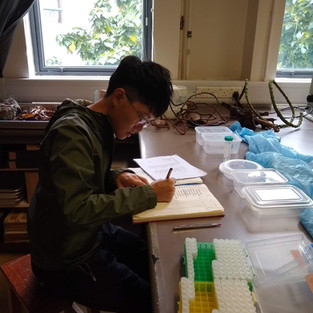Starting a collection from scratch!
- Itzue W. Caviedes-Solis

- Sep 14, 2020
- 9 min read
Updated: Nov 4, 2021
從零開始的藏品庫
Translated by Sibbie LI 李曉詩, Edited by Mei CHAN 陳美恩
¡Iniciando una colección desde cero!
Translated and edited by María Teresa NEGREROS AMAYA
Natural history collections are like libraries about animals, but instead of books they have preserved animals that teach us about biology. My academic career started as a volunteer at a herpetology collection when I was a third-year undergraduate student. The collection is part of the Zoology Museum “Alfonso L. Herrera” at the National Autonomous University in Mexico, where I am from. The collection had hundreds of jars full of amphibians (frogs, toads, salamanders and caecilians) and reptiles (lizards, snakes, turtles and crocodiles). I was born and raised in the chaotic, highly-urbanized Mexico City with 23 million other people, so the animals in the jars from the collection were like nothing I had ever seen before. The collection manager Mundo taught me a lot, from how to identify specimens to how to use the collection for research. Thirteen years later I still incorporate museum specimens in all my research projects and the smell of dead amphibians and reptiles in alcohol still gives me a sense of home and happiness. That is why when I joined Lingnan University under the supervision of Dr. Fong to start a collection I was thrilled!
But why are natural history collections important? Collections around the world help to answer research questions about local species. The specimens provide a snapshot of diversity through time. Specimens can tell us about the environment of a region and the ecology and reproduction of organisms (among many other things). As technology advances, collections are also important resources for DNA studies. Collections are an interesting way to teach about local biodiversity to the general public for which wilderness is not accessible, and to create awareness of the species sharing your backyard.
When you compare starting a brand-new natural collection with well-established, centuries old natural history museums around the world, the process sounds overwhelming and exciting. But everyone starts somewhere right? At Lingnan University Dr. Fong had the vision to build a natural history collection of Hong Kong’s amphibians for conservation and education. The collection started in 2019 to contribute to the goals of Hong Kong's Biodiversity Strategy and Action Plan and it is funded by The Environment and Conservation Fund.
So how exactly do you build a collection? We collect specimens by hand in the wild. We bring the specimens to the lab where we take a picture while they are alive for reference, then we follow a protocol to preserve them, including formaldehyde and alcohol. For each of our specimens we take small pieces of liver to storage their DNA. Specimens in the collection are organized by species in jars of alcohol and the collection database is part of the international data management system Arctos and will be public and available for scientists around the world.
A place like Hong Kong is a prime location to start a collection. Despite widespread urbanization, 40% of the Hong Kong area is still under some degree of protection. Hong Kong hosts 23 species of amphibians and at least 77 species of reptiles. Our collection is located at Lingnan University, the liberal arts university in Hong Kong. Lingnan University encourages faculty and students to contribute to society through research and knowledge transfer and it provides a supportive environment with adequate infrastructure. This, combined with our knowledgeable and capable team, is helping us succeed with the ambitious project of starting a natural history collection from scratch.
Our main goal as a natural history collection is to document Hong Kong biodiversity. However, you don’t need to be part of a collection to contribute to increasing biodiversity knowledge. You can use online platforms such as iNaturalist. By uploading your pictures, they become important records. You can also share what you know about Hong Kong species in social media or teaching your family and friends about the importance of amphibians and reptiles. Together we can increase awareness about how cool amphibians and reptiles in Hong Kong are. But learning more about them we will be better able to conserve them.
Learn more about the collection in its website
and in this media coverage by Lingnan University
https://www.ln.edu.hk/research-and-impact/stories/lingnan-spawns-a-new-natural-history-collection/
Pictures by Itzue W. Caviedes-Solis, featuring Ivan Lam, collection manager.
從零開始的藏品庫
Translated by Sibbie LI 李曉詩, Edited by Mei CHAN 陳美恩
自然藏品庫就像動物圖書館,不過它收藏的並非書本,而是以保育動物的方式來教導我們生物學。當我還是大學三年級時,我以義工的身份去處理一批爬蟲學的藏品,從此,我的學術生涯便開始了。那批藏品是阿方索·埃雷拉(Alfonso L. Herrera)動物學博物館的一部份館藏,博物館位於墨西哥國立自治大學,與我來自同一個城市。館藏中有數百個裝滿兩棲動物(青蛙、蟾蜍、蠑螈和蚓螈)和爬行類動物(蜥蜴、蛇、海龜和鱷魚)的玻璃瓶。在墨西哥城出生和長大的我,生活於一個擁有2300萬人口,高度城市化又雜亂的地方,因此,瓶裏的動物是我從未見過的。由如何辨別標本,到利用館藏進行研究,館藏經理蒙多(Mundo)教會我很多。十三年後,我所有的研究項目仍然包含館藏標本,而浸泡在酒精中的兩棲和爬行動物屍體的氣味,仍然給我一種家和幸福的感覺。這就是為什麼,當我開始在嶺南大學方博士的指導下開始建立藏品庫時,我是如此雀躍!
不過,為甚麼自然藏品這麼重要呢?世界各地的藏品有助解答本地物種的研究問題。隨着時間的流逝,標本提供了多樣性的快照。它還告訴了我們一個地區的環境,以及生物的生態和繁殖狀況(還有很多其他的資訊)。科技的進步亦令藏品成為DNA研究的重要資源。藏品以一種有趣的形式,向大眾展示那些他們難以接觸的野生本土生物,令他們認識香港這個後花園的生物多樣性
當你將開展一個嶄新的自然藏品庫,和那些在世界各地廣為人知、歷史悠久的自然史博物館館藏相比,整個過程聽起來就讓人抑制不住的興奮。但我們總得有個起點,對吧?嶺南大學的方博士希望透過建立自然藏品庫,推動兩棲動物的保育和教育。該計劃於2019年開始發展,目標為香港的《生物多樣性策略及行動計劃》出一分力,並由環境及自然保育基金(環保基金)資助
那麼,究竟如何建立藏品庫呢?我們親自在野生環境中收集樣本。我們先將樣本帶到實驗室,在牠們仍生存時拍照以作日後參考,我們亦會抽取牠們一小部份肝臟,用來儲存牠們的DNA。然後按照規程,使用甲醛和酒精去保存牠們,製成標本。標本按品種分類,放在裝有酒精的玻璃瓶中,而藏品的資料庫屬於國際數據管理系統(Arctos)的一部分,可供公眾及世界各地的科學家查閱及使用.
而像香港這樣的地方,是建立藏品庫的理想地點。雖然香港到處都已被城市化,但仍有40%的地區受到一定程度的保護。香港有23種兩棲動物和至少77種爬行動物。我們把藏品庫設置在香港一所博雅大學—嶺南大學當中。嶺南大學鼓勵師生通過研究和知識轉移為社會作出貢獻,並提供一個基礎設施完備的良好環境。再加上我們博學又能幹的團隊,讓我們從零開始建立自然藏品庫這個雄心壯志的計劃,得以邁向成功。
我們建立自然藏品庫主要是為了記錄香港的生物多樣性。不過,你無須成為藏品庫的一員,亦可協助推廣生物多樣性的知識。你可以使用一些網絡平台如iNaturalist (iNat),只要上傳生物的圖片到平台上,牠們便會成為重要的記錄。你亦可以在社交媒體上分享你對香港物種的了解,或教導家人和朋友關於兩棲和爬行動物的重要性。我們可以一起令更多人意識到香港的兩棲和爬行動物有多酷。越了解牠們,我們才能更好地保護牠們
瀏覽嶺南大學的媒體報導,了解更多關於藏品庫的詳情:
圖片由 Itzue W. Caviedes-Solis 提供,feat. 館藏經理林沛賢
¡Iniciando una colección desde cero!
Translated and edited by María Teresa NEGREROS AMAYA
Las colecciones de historia natural son como bibliotecas sobre animales, pero en lugar de libros resguardan especies preservadas que nos enseñan sobre biología.
Mi carrera académica comenzó como voluntaria en una colección de herpetología cuando era estudiante estudiante de licenciatura de tercer año; esta colección actualmente forma parte del Museo de Zoología “Alfonso L. Herrera” de la Universidad Nacional Autónoma de México, el país de dónde soy originaria. La colección tenía cientos de frascos llenos de anfibios como ranas, sapos, salamandras o cecilias; y reptiles como lagartos, serpientes, tortugas y cocodrilos. Nací y crecí en la caótica y altamente urbanizada Ciudad de México, con otros 23 millones de personas, así que los animales en los frascos eran algo que nunca había visto antes.
Durante mi voluntariado, Mundo, el director de la colección, me enseñó mucho: desde cómo identificar especímenes hasta cómo utilizar la colección para la investigación. Trece años más tarde, aún incorporo especímenes de museos en todos mis proyectos. El olor de los anfibios y reptiles conservados en alcohol todavía me brinda una sensación de hogar y felicidad, es por esto que me emocioné mucho cuando me uní a la Universidad de Lingnan, bajo la supervisión del Doctor Fong, para comenzar una colección.
¿Por qué son importantes las colecciones de historia natural?
Las colecciones de todo el mundo ayudan a responder preguntas de investigación sobre especies locales. Los especímenes proporcionan una instantánea de la diversidad a través del tiempo; pueden hablarnos sobre el medio ambiente de una región, la ecología y la reproducción de organismos, entre muchas otras cosas. A medida que avanza la tecnología, las colecciones también se han convertido en recursos importantes para los estudios de ADN.
Al mismo tiempo, las colecciones también pueden ser una forma interesante de enseñar sobre la biodiversidad local al público en general (para el que la naturaleza no es totalmente accesible, pero tampoco ajena); por lo que es importante crear conciencia de lasesa especies con la que las personas comparten su patio trasero.
¿Cómo se construye una colección?
Comparar la puesta en marcha de una nueva colección con museos de historia natural bien establecidos alrededor del mundo con cientos de años de respaldo, puede resultar abrumador (y al mismo tiempo emocionante), pero todo el mundo empieza desde algún lugar, ¿no es cierto?
En la Universidad de Lingnan, el Doctor Fong tuvo la visión de construir una colección de historia natural de los anfibios de Hong Kong para la conservación y la educación. El proyecto comenzó en 2019, esto con el propósito de contribuir a los objetivos de la Estrategia y Plan de Acción para la Diversidad Biológica de Hong Kong, y está financiado por el Fondo para el Medio Ambiente y la Conservación.
Para comenzar la recopilación, en Lingnan recolectamos especies de forma manual directamente de la naturaleza. Mientras están vivas, las llevamos al laboratorio donde tomamos una foto como referencia. Para la preservación de los ejemplares seguimos un protocolo que utiliza formol y alcohol; pero antes, tomamos pequeños trozos de hígado de cada uno de nuestros especímenes para almacenar su ADN.
Los animales preservados se organizan por especies en frascos de alcohol, la información recopilada forma parte de la base de datos del sistema internacional de manejo de datos Arctos, la cual será pública y estará disponible para científicos de todo el mundo.
¿Por qué iniciar una colección en Hong Kong?
Hong Kong es un lugar importante para iniciar una colección. A pesar del alto nivel de urbanización, el 40% del territorio de Hong Kong tiene cierto grado de protección: alberga 23 especies de anfibios y al menos 77 especies de reptiles.
Nuestra colección se encuentra en la Universidad Lingnan, la universidad de artes liberales en Hong Kong, lugar donde se alienta a los profesores y estudiantes a contribuir a la sociedad a través de la investigación y la transferencia de conocimiento; pero, al mismo tiempo, proporciona un entorno de apoyo con una infraestructura adecuada. Esto, combinado con nuestro equipo experto y capaz, nos está ayudando a tener éxito con el ambicioso proyecto de iniciar una colección de historia natural desde cero.
El objetivo: el conocimiento de la biodiversidad
Como colección de historia natural, el principal objetivo es documentar la biodiversidad de Hong Kong. Sin embargo, no es necesario formar parte de una colección para contribuir a aumentar el conocimiento de la biodiversidad. Una forma de contribución es la utilización de plataformas en línea como iNaturalist; subir tus fotos, es un registro importante. También puedes compartir lo que sabes sobre las especies de Hong Kong en las redes sociales, o enseñar a tu familia y amigos sobre la importancia de los anfibios y reptiles.
Juntos podemos aumentar la conciencia acerca de lo geniales que son los anfibios y reptiles en Hong Kong. Aprendiendo más sobre ellos podremos conservarlos mejor.
Para aprender más sobre la colección visita su página web
Y la cobertura de prensa de la Universidad de Lingnan
https://www.ln.edu.hk/research-and-impact/stories/lingnan-spawns-a-new-natural-history-collection/
Fotografías tomadas por Itzue W. Caviedes-Solis, en las que se muestra Ivan Lam, técnico de la colección.
















Comments